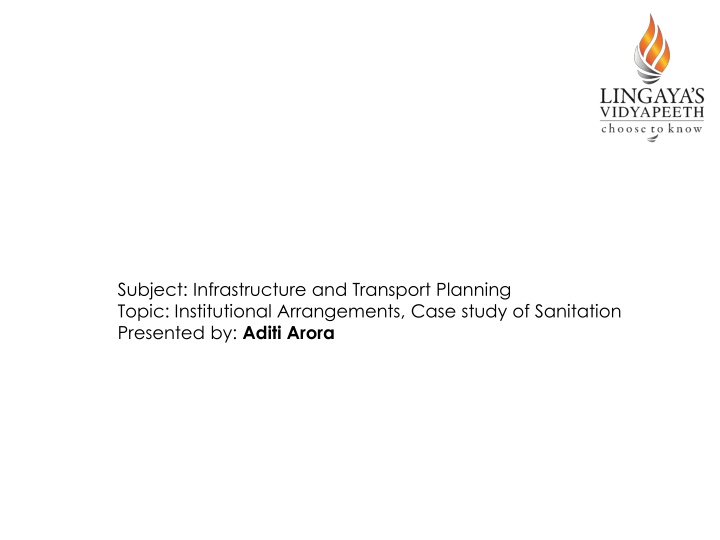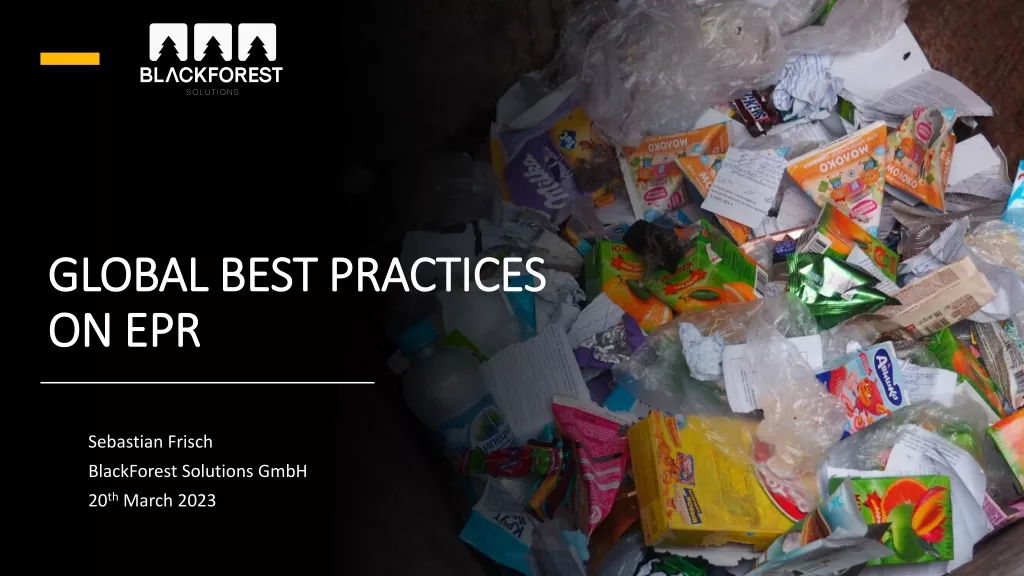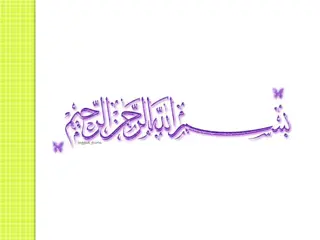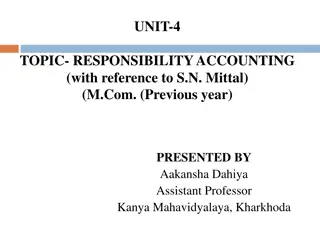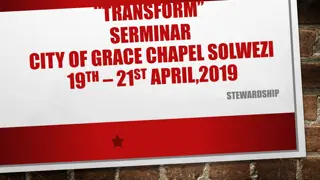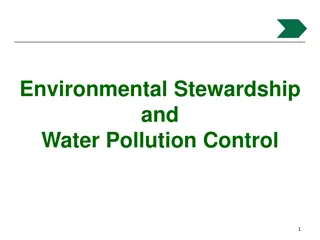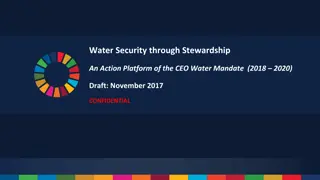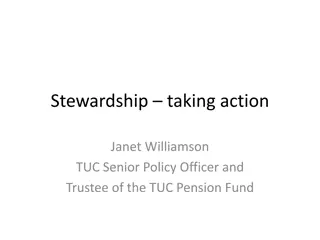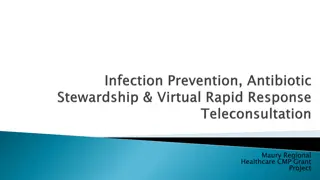Environmental Stewardship and Responsibility
Christian responsibility for environmental stewardship is highlighted through various examples of environmental degradation and its impacts on health, wildlife, and ecosystems. Urgent actions are needed to address pollution, plastic waste, e-waste, and climate change to ensure a sustainable future for all.
Download Presentation

Please find below an Image/Link to download the presentation.
The content on the website is provided AS IS for your information and personal use only. It may not be sold, licensed, or shared on other websites without obtaining consent from the author.If you encounter any issues during the download, it is possible that the publisher has removed the file from their server.
You are allowed to download the files provided on this website for personal or commercial use, subject to the condition that they are used lawfully. All files are the property of their respective owners.
The content on the website is provided AS IS for your information and personal use only. It may not be sold, licensed, or shared on other websites without obtaining consent from the author.
E N D
Presentation Transcript
Subject: Infrastructure and Transport Planning Topic: Institutional Arrangements, Case study of Sanitation Presented by: Aditi Arora
INSTITUTIONAL ARRANGEMENTS Sanitation includes the major engineering infrastructure items: Excreta management systems. Wastewater management systems. Solid waste management systems. Drainage systems for rainwater, also called storm water drainage.
ULB: ROLE IN SANITATION Ensure access to efficient, affordable, economical and sustainable measures to waste water services in the city. Make by-laws. Prepare a water services development plan. Decide on appropriate mechanism for providing waste water services by means of proper sanitation and waste water treatment mechanism. Perform the function of waste water services provider itself (internal mechanism) or contract a waste water services provider (external mechanism).
ULB: A CASE STUDY OF DELHI MUNICIPAL CORPORATION OF DELHI (MCD) Regulate the overall scenario of waste water treatment and disposal. Set up bye-laws and policies associated with waste water disposal and treatment. Delhi Cleanliness and Sanitation Bye-laws, 2009. Volumetric pricing rate for Delhi : Rs. 2.66 VC/KL + Rs. 66.55 SC + 60% on VC for sewerage, for class of 0-10 KL consumption. DELHI CANTONMENT BOARD (DCB) 80% of water supplied (7.8 MGD average) is considered as sewerage received from DCB. In effect 80% of ground water drawn from tube wells should also be considered. Sewerage is being disposed off in the central sewerage line along the station road going to Keshopur STP.
ULB: A CASE STUDY OF DELHI NEW DELHI MUNICIPAL COUNCIL (NDMC) The NDMC receives 115 to 120 MLD water in bulk through 19 bulk meters from the DJB and draws 18 to 20 MLD of groundwater drawn from 137 tube wells to supplement water supply in its area having 352 km length of water mains (4 inches to 42 inches in diameter) and operates 23 UGR & BPS. The distribution system is maintained by the NDMC. 80% of water supplied by DJB is considered as sewerage received from NDMC. Sewer system is in existence having a length of 350 km varying from 4 inches to 2100 mm in diameter. Sewer System including two Sewage Pumping Stations is operated and maintained by NDMC. Brick sewers are old and settlements are occasionally observed both on brick sewers as well as NP2 class RCC sewers. Sewage is delivered to DJB for treatment.
KEY CHALLENGES The entire system of institutional arrangement is complex and fragmented. Over centralized, top-down approach, without any decentralization to the ULBs as par XIIth schedule of 74th C.A.A.,1992. Separation of capital works and operational responsibilities create O and M cost recovery problems. Limited local accountability to the consumers if service is provided by State board/authority. Limited social, environmental and financial sustainability. ULBs have no say in the design of the capital works/schemes that they have to run or maintain. Local capacity constraint.
HINDRANCES TO EFFECTIVE WASTEWATER MANAGEMENT City level Neighbourhood level Household level Physical/ planning Hyper-urbanisation, increasing informality & planning failures. Lack of monitoring tools and information system. Fragmented and unclear institutional responsibilities. Multiple authorities in-charge. Weak financial base. Institutional corruption. Lack of accountability. No coordinating body. Lack of sustained political will. Socio - cultural Economic Behavioural Legal Political
PLANNING PROVISION AND MANAGEMENT ISSUES Issues related to the status of Sewerage An estimated 530 MGD of untreated sewage is discharged into the river Yamuna. Due to network deficiencies, there is an overflow from sewers into storm water drains. Trunk sewers are considerably silted, requiring desilting & repair to restore their capacity in a time bound manner. The city s STPs and Sewage Pumping Stations are several years old - leading to reduced efficiency. Upgrading conveyance system needs to be undertaken, for full capacity utilization of Common Effluent Treatment Plants. Strategies for Civic Infrastructure Development: Strategies for sewerage include (i) Extension and up-gradation of sewage network to intercept sewage (abatement of pollution); (ii) Provision of Sewer Network in un-sewered area; (iii) Augmentation of Sewage Treatment Capacity.
ISSUES REQUIRING ATTENTION 1. Whereas sewage generation is 719 MGD as per CPCB publication, Feb 2005, the cumulative inflow at the STPs is around 346 MGD only out of which 72 MGD is partially treated at Keshopur STP. Thus in effect only 346 76 = 270 MGD of sewage is fully treated. 2. Present day generation of sewage is estimated at 800 MGD, as such 800 270 = 530 MGD of untreated sewage is polluting the river Yamuna. 3. Keshopur STP is in URGENT need of renovation and restoration of designed capacity. 4. Owing to overflow from sewers into storm water drains (SWDs), there is urgent need to segregate the sewage flow from entering into SWDs. 5. Govt. of NCT of Delhi may review the policy of laying sewers in un authorised colonies as a matter of pollution abatement. 6. Process of laying sewers in unauthorized regularised colonies, urbanvvillages may be reviewed and impediments removed in completing the remaining work. As many as 61 unauthorised regularised colonies and 30 urban villages are yet to be provided with sewerage system. 7. The trunk sewers are reported to be considerably silted, and need to be desilted, repaired and renovated, where ever required, to restore their capacity in a time bound manner. 8. Efficiency of STPs and Sewage Pumping Stations may be verified (as many of them are several years old) to ascertain to actual quantity of sewage pumped and reaching the STPs. Presently, inflows are based on rated capacity of pumping.
9. There is need to generate power from the sewage gas obtained from the sludge digestors to tide over power problems as also as a measure of abatement of air pollution. 10. Utilisation of treated sewage effluents for gardening and agricultural need may not only be explored but implemented as early as possible so that irrigation demand is met from treated effluents. 11. The design capacity of CETPs needs to be optimally utilized and the conveyance system needs to be checked for full capacity utilization. 12. A suitable methodology needs to be worked out for scientific disposal of sludge (rich in chemicals, heavy metals etc.) From these CETPs. 13. Un-interrupted power supply and stable voltage at STPs and SPSs is a necessity to maintain sewerage treatment pumping of sewerage.
SEWERAGE SYSTEM DJB is the agency of the Govt. of NCT of Delhi responsible for collection, treatment and disposal of wastewater. Projects which effectively resolve the present drawbacks of the system have been taken up on a priority basis. Summary of Strategies Strategies identified, in order of priority are given below: i) Extension and up-gradation of sewage network to intercept sewage (abatement of pollution). ii) Provision of sewer network in un-sewered areas. iii) Augmentation of sewage treatment capacity (i) EXTENSION AND UPGRADATION OF SEWERAGE NETWORK These projects aim to revamp and upgrade the existing sewer network. These include providing sanitation to uncovered areas of the city. The projects covered as part of extension and up-gradation of sewerage network are: (a) Revamping and Rehabilitation of Trunk & Internal Sewerage Network: In order to improve the sewage collection and disposal system in already sewered area, it has been proposed to revamp and upgrade (including replacement) about 650km of internal sewer network; and rehabilitate 150km of trunk sewer network in walled city area, north & west districts of city (excluding sewer under YAP-II). This latter component will include the procurement of suction and jetting machines, CCTV etc. to ensure adequate maintenance (if maintenance is not to be out-sourced) (b) Refurbishment of Sewage Pumping Stations: The refurbishment of existing sewage pumping stations (SPS) will aim at optimal functioning of these plants.
(ii) PROVISION OF SEWER NETWORK IN UN-SEWERED AREAS Projects included are (a) Laying of Sewer Network in Uncovered Areas: The provision of 250km of trunk sewer network in uncovered area and laying of sewer network in 169+39 villages & 1513 unauthorized/regularized colonies to improve the sanitation system in these areas. (b) Construction of new sewage pumping stations: These will allow diversion of sewage from uncovered areas to the appropriate STP, for optimal utilisation of the STP s. These are proposed at Punjabi Bagh,Nangloi extn, Preet vihar, Yamuna vihar and Jivan Vihar (iii) AUGMENTATION OF SEWAGE TREATMENT CAPACITY Projects proposed include (a) Construction of STPs along intercepting sewers: Total estimated project cost is 700 Crores (b) Construction of Sewage Pumping Stations: These will upgrade sanitation facilities in low lying areas. The cost of constructing the SPS s is Rs. 150 Crore (c) Laying of Intercepting Trunk Sewers along Three Main Drains: Consideration of this proposal is subject to the recommendations of the consultant due to be appointed to advice on this issue. Cost allocated is Rs. 500 Crore in the first phase.
